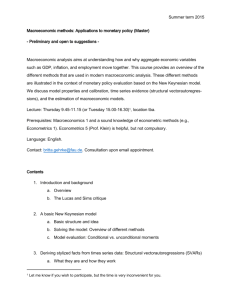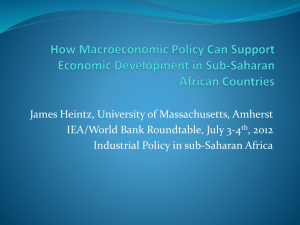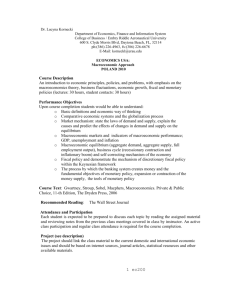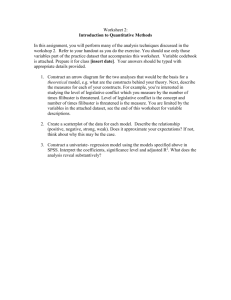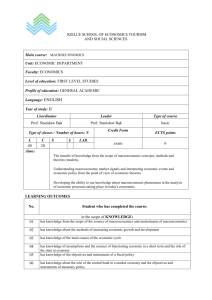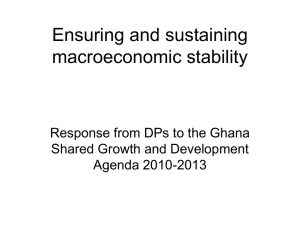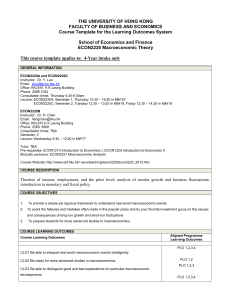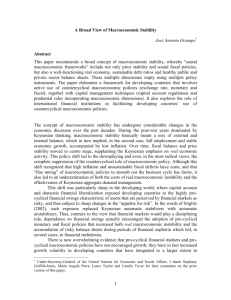УДК: 330:323:338 Martuniuk Ivan Volodymyrovych Kiev national
advertisement
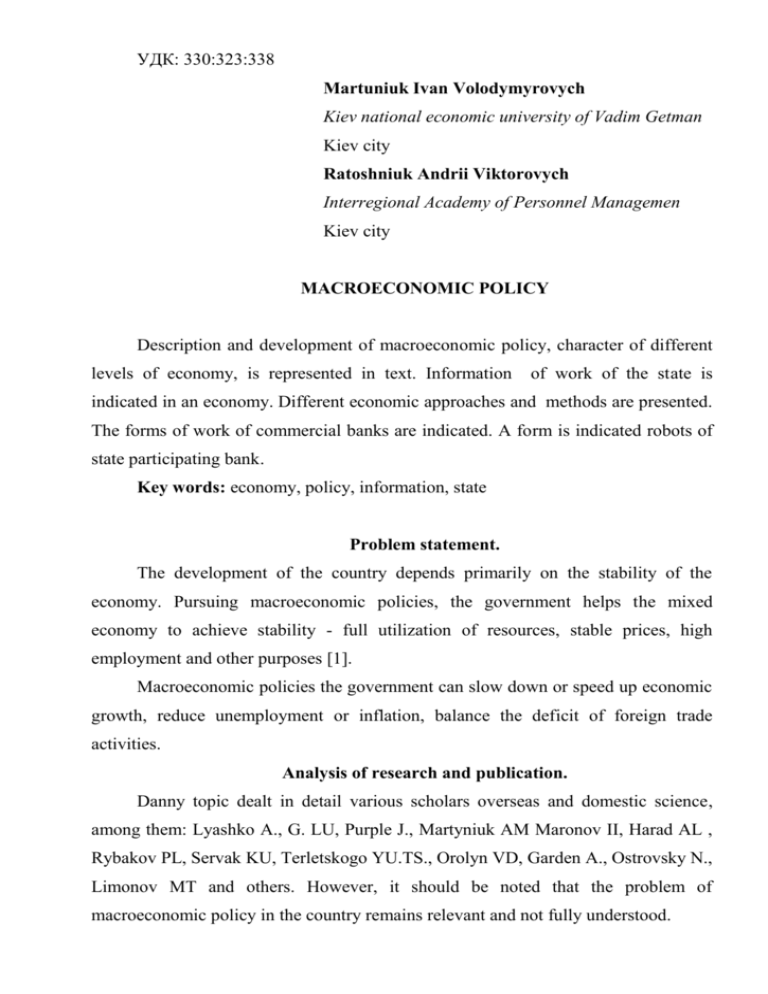
УДК: 330:323:338 Martuniuk Ivan Volodymyrovych Kiev national economic university of Vadim Getman Kiev city Ratoshniuk Andrii Viktorovych Interregional Academy of Personnel Managemen Kiev city MACROECONOMIC POLICY Description and development of macroeconomic policy, character of different levels of economy, is represented in text. Information of work of the state is indicated in an economy. Different economic approaches and methods are presented. The forms of work of commercial banks are indicated. A form is indicated robots of state participating bank. Key words: economy, policy, information, state Problem statement. The development of the country depends primarily on the stability of the economy. Pursuing macroeconomic policies, the government helps the mixed economy to achieve stability - full utilization of resources, stable prices, high employment and other purposes [1]. Macroeconomic policies the government can slow down or speed up economic growth, reduce unemployment or inflation, balance the deficit of foreign trade activities. Analysis of research and publication. Danny topic dealt in detail various scholars overseas and domestic science, among them: Lyashko A., G. LU, Purple J., Martyniuk AM Maronov II, Harad AL , Rybakov PL, Servak KU, Terletskogo YU.TS., Orolyn VD, Garden A., Ostrovsky N., Limonov MT and others. However, it should be noted that the problem of macroeconomic policy in the country remains relevant and not fully understood. Tasks statement. The purpose of this study is the in depth study of the Institute of macroeconomic policy in Ukraine. Investigate using various forms and methods of functioning of the mechanism and the structure of the economy as a whole and in its individual manifestations. The main material of the study. Macroeconomic policy - is the work of the state to create legal and economic conditions necessary to achieve stability of the national economy. In its macroeconomic policy, the government relies on the market mechanism and several government instruments [2]. All government tools can be divided into three types: - Legal, - Administrative; - Economic. Legal instruments - a legal documents and regulations that govern the basic rules of the economic activities of participants in the market process. They set out the rights and obligations of legal entities and individuals, as well as possible sanctions for their violation. Among the legal instruments are the most important laws on property, plant, investment and economic activity taxes and social security, banking and more. Administrative tools - it decrees, regulations, executive orders, which allow, prohibit, restrict or pertain to certain types of economic activity [3]. For example, setting quotas, environmental regulations, licensing and more. Economic instruments - a state budget, taxes, interest rates, etc.. Of all the macroeconomic objectives toughest two - full employment and stable prices. All kinds of macroeconomic policies (fiscal, monetary, foreign policy and incomes policy) aimed at achieving macroeconomic stability. Among economists, common two alternative views on the effectiveness of macroeconomic policies - Keynesian and classical [4]. Keynesian approach is based on the following principles: 1) modern market economy for a long time can unuse resources, output will be below potential because of insufficient aggregate demand; 2) the market mechanism can not turn the national economy to full employment after shocks - depression and social disturbances; 3) Governments have real impact tools - macroeconomic policies - to return the economy to full employment; 4) if the government currently has no reliable economic projections, it will get them later, which enables him to follow the right strategy; 5) economic policy should be developed on a scientific basis, based on the cooperation of politicians and economists. So Keynesians justify the need for state intervention in economic life. Proponents of the classical approach believe that: 1) economics always provide full employment and the use of resources, it tends to potential output in the long run; 2) the economy will not suffer losses in the macroeconomic sense underutilization of resources because of insufficient aggregate demand; 3) the government can only affect the price level, but can not affect output and employment. Fiscal policy. Fiscal policy is connected with the state budget. It involves the purposeful adjustment of taxes and public spending to achieve the selected macroeconomic objectives. Taxes and government spending - are the main instrument of fiscal policy. Fiscal policy as a tool of macroeconomic regulation used by over half a century. [5] With fiscal policy the government can change the structure of the national economy, reduce cyclical fluctuations, achieve full employment, promote economic growth, manage public finances, fight inflation flares etc.. There are two types of fiscal policy: stimulating and a weak [6]. Stimulative policy aimed at maintaining high economic growth and a high level of employment. For its implementation the government increases spending, reduce taxes or somehow combines these two measures. This increases investment, GDP and reduce unemployment. For deterrence policy the government aims to reduce inflation demand through increasing taxes, reducing government spending or a combination of these two measures. Stimulative fiscal policy to increase public spending and reduce taxes. It operates in the direction of increasing the budget deficit. Restrictive fiscal policy, by contrast, operates in the direction of a budget surplus provides for reductions in government spending or increase taxes. Public debt - the total amount owed to the government for issued and outstanding loans (including accrued interest). Public debt is part of the national debt. [7] National debt includes debt of public and private sector to domestic and foreign creditors. Monetary policy. Fiscal policy is slow. Therefore, to achieve certain macroeconomic goals often used monetary policy. Monetary or monetary, politics - is the impact on the money supply in the economy in order to achieve macroeconomic stability. Monetary policy usually holds the central bank of the country, in our country - the National Bank of Ukraine (NBU) [8]. There tight monetary policy aimed at curbing inflation, demand and stimulating monetary policy, through which reaches reducing unemployment. Through a weak policy, the central bank reduces the supply of money (politics "expensive" money), which increases interest rates and reduces investment, thus reducing GDP and inflation. Stimulative monetary policy increases the money supply (the policy of "cheap" money), reducing interest rates and stimulate economic activity. Central bank changes the money supply in the economy, using the following tools: reserve ratio, discount rate, open market operations. Reserve ratio - the percentage of deposits (deposits) that commercial banks must keep with the central bank in the form of required reserves. [9] Commercial banks often take the money as a loan from the central bank, for which it charges interest. The interest rate at which the central bank lends to commercial banks, called the discount or the discount rate. In Ukraine it is called refinancing. Raising the discount rate reduces the interest of commercial banks in obtaining additional reserves through loans from the central bank. Therefore, raising the discount rate reduces the supply of money in the economy. Conversely, lowering the discount rate encourages commercial banks to additional reserves through loans from the central bank. The money supply in the economy increases. Operations on the open market for buying and selling of central bank securities. In a developed market economy, open market operations is an important tool by which the central bank controls the money supply. As buying and selling of government securities affect the excess reserves of commercial banks. Through stimulating monetary policy, the central bank: 1) reduces the rate of redundancy; 2) reduces the discount rate; 3) buying government securities. Thanks to these measures, the central bank increases the money supply, interest rates are reduced, resulting in increased domestic investment, consumption of durable goods, aggregate demand and real national product. Tight monetary policy to: 1) increase the reserve ratio; 2) an increase in the discount rate; 3) sale of government securities. Thanks to these measures, the money supply in the economy is declining, interest rates rise and investment, aggregate demand and inflation reduced. Conclusions from the study. Fiscal and monetary policy - the basic methods employed by the state to achieve certain macroeconomic goals - a slowdown in inflation, reduce unemployment and increase national output. However, there are other kinds of macroeconomic policies that help stabilize some areas of macroeconomics [10]. State as for multiple factors and the presence of at least three branches of government, as the legislature, executive government and judiciary, is rather complicated mechanism. This mechanism is operational and running for several conditions, one of the main conditions it is cooperation of such financial bodies policies such as the National Bank of Ukraine on the one hand and the executive in the face of the Cabinet of Ministers of Ukraine on the other. Also important in building of mmacroeconomic policy plays cooperation at the regional level, namely at the level of the regions and districts. The used literature list: 1. Борисов Е. Ф. Основы экономики: Учебник для студентов средних специальных учебных заведений.– М.: Юристь, 1998.– 336 с. 2. Загальна економіка: Підручник / За ред. І. Ф. Радіонової .– 2-ге вид., доп. і перероб.– К.: А.П.Н., 2000. 3. Задоя А. А., Петруся Ю. Е. Основы экономики: Учеб. пособие. – К.: Вища шк. – Знання, 1998. 4. Економіка: Підруч. для 10 кл. загально освіт. навч. закл./ Г. О. Ковальчук, В. Г. Мельничук, В. О. Огнев’юк. – К.: Навч.книга, 2003.– 352 с.: іл. 5. Економіка: Навч. посібник для 10 – 11 класів / За ред. З. Г Ватаманюка, С. М. Панчишина.– К.: Либідь,1999. 6. Экономическая теория в вопросах и ответах: Учебное пособие. – Ростов н/Д: Изд-во “Феникс”, 1998. – 512 с. 7. Экономическая теория: Учеб. для студ. высш. учеб. заведений/ Под ред. В. Д. Камаева. – 5-е изд., перераб. и доп.– Гуманит. изд. центр ВЛАДОС, 1999. – 630 с.: ил. 8. Кемпбелл Р. Макконнелл, Стенлі Л. Брю. Аналітична економія принципи, проблеми і політика. Частина 2. Мікроекономіка. 13-е видання. Пер. з анг. – Л.,: Просвіта, 1999.– 650 с. 9. Козырев В. М. Основы современной экономики: Учебник. – М.: Финансы и статистика, 1998. – 368 стор: ил. 10. Меньшиков С. М. Новая экономика. Основы экономических знаний. Учебное пособие.– М.: Междунар. отношения, 1999. 400 с.

